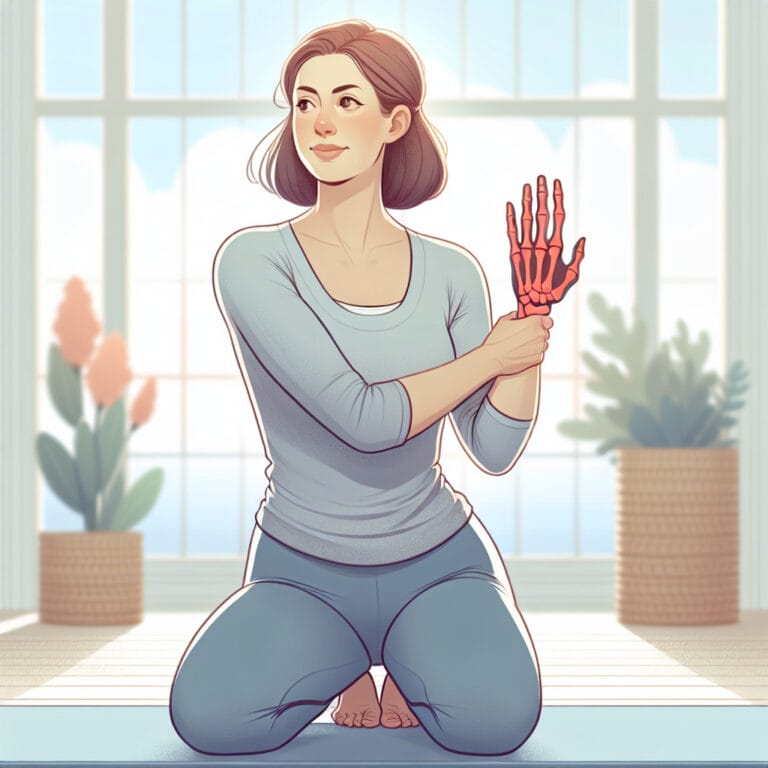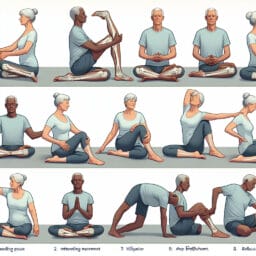
Effective Yoga Poses for Managing Rheumatoid Arthritis
Table of Contents
- Introduction
- Understanding Rheumatoid Arthritis
- Role of Yoga in Rheumatoid Arthritis Management
- Effective Yoga Poses for Rheumatoid Arthritis
- Tips for practicing Yoga with Rheumatoid Arthritis
- Conclusion
- Frequently Asked Questions
Introduction
Living with rheumatoid arthritis (RA) entails wrestling with soreness, stiffness and often unyielding pain. Standard medical treatment can help manage these symptoms, but for many RA patients, integrating a mind-body approach such as yoga into their routine has shown promising results. Studies have found that practicing specific yoga poses can moderate the detrimental arthritis effects on the body, boost flexibility and strength while promoting relaxation to lower stress—a significant catalyst of RA symptoms. The gentle stretching and deep breathing involved in Iyengar yoga were reported by several individuals to ease chronic pain significantly. Furthermore, some findings suggest yoga—being part of a holistic therapy strategy—might directly address disease activity. While improvements in people’s rheumatoid condition showed uncertain benefits due to individual differences, it was undeniable that yoga helped foster an improved quality of life for many. The key lies not just in the physical postures; the mental discipline cultivated through regular practice helps people better tolerate discomfort and navigate daily challenges more buoyantly. Thus, incorporating suggested yoga regimens under professional supervision from a certified yoga instructor might be worth considering if you’re seeking ways to manage pain from RA effectively.
Understanding Rheumatoid Arthritis
Rheumatoid arthritis (RA) is an autoimmune disorder that primarily affects the joints. It causes painful swelling, resulting in severe joint damage and deformity if not treated appropriately. It’s a chronic condition wherein the body’s immune system mistakenly attacks its tissues, going beyond the confines of the joints and possibly affecting other body parts like skin, eyes, lungs, heart and blood vessels. Its symptoms often involve warm, swollen and tender joints, stiffness that is usually worse in mornings or after periods of inactivity, fatigue, fever and weight loss. Undeniably living with RA can be overwhelming; it can interfere with everyday activities due to persistent pain making simple tasks challenging. In many cases this leads to stress which further exacerbates RA symptoms.
The profound arthritis effects ripple beyond physical health; it weighs heavily on people’s minds as they grapple with managing constant discomfort while maintaining a semblance of normalcy in their lives. Research shows that individuals suffering from rheumatoid arthritis often battle increased anxiety levels too—an unfortunate byproduct of trying to cope with relentless unease and uncertainty over future health status. Hence developing an effective coping mechanism is essential for RA patients not just to manage pain but also to foster mental resilience amid adversity—the very core tenets offered by Yoga therapy.
Role of Yoga in Rheumatoid Arthritis Management
A shift towards holistic health has led to the exploration of alternative therapies for managing chronic illnesses, and yoga has emerged as a popular choice. The centuries-old practice, known for its mind-body approach, is increasingly being acknowledged as an effective way to manage pain and lower stress in rheumatoid arthritis patients. Scientific studies have begun to validate these benefits; people with RA who included yoga practice in their routine reported significant improvements in their symptoms. One such study found that Iyengar yoga, known for its focus on precision and alignment, helped ease chronic pain in individuals with RA. Participants practiced specific yoga poses under the guidance of a certified yoga instructor, which not only increased flexibility but also fostered mental resilience. This dual advantage is crucial considering arthritis effects both physical mobility and mental well-being due to persistent discomfort and stress associated with the disease activity. While standard medical treatment remains irreplaceable, findings suggest Yoga can be an excellent supplementary therapy offering more than just physical relief—it provides a therapeutic space where RA patients learn to navigate their condition optimistically. Thus incorporating suggested yoga regimens could enrich the quality of life for people grappling with Rheumatoid Arthritis—however uncertain benefits might be individually it’s undeniable that many find solace on their mat amidst the tumultuous journey of dealing with RA.
| Title | Role of Yoga in Rheumatoid Arthritis Management |
|---|---|
| Overview | The article discusses the role of yoga, especially Iyengar yoga, in managing rheumatoid arthritis (RA) symptoms. It emphasizes the dual advantage of yoga in increasing physical flexibility and fostering mental resilience. |
| Importance of Yoga in RA | Along with standard medical treatment, yoga can be an excellent supplementary therapy offering more than just physical relief. It provides a therapeutic space where RA patients can navigate their condition optimistically. |
| Benefits of Yoga in RA | Scientific studies have shown that individuals with RA who practice yoga have reported significant improvements in their symptoms. The practice of Iyengar yoga, known for its focus on precision and alignment, has been found to ease chronic pain in individuals with RA. |
| Image |
Effective Yoga Poses for Rheumatoid Arthritis
Residing in the realms of ancient wisdom and modern science, yoga’s transformative influence on rheumatoid arthritis (RA) patients offers a beacon of hope. Immersing oneself in specific yoga poses could be instrumental in managing RA symptoms, enhancing physical resilience while fostering emotional equilibrium. For instance, consider the child’s pose; this humble posture brings ease to chronic pain by gently stretching the hips, thighs and ankles while offering a soothing effect on the mind. The bridge pose is another gem from Iyengar Yoga; it helps to lower stress levels and promotes spinal health—crucial for those wrestling with arthritis effects. The seated forward bend can alleviate stiffness and promote flexibility—a boon for RA patients who often grapple with mobility issues due to swollen joints.
Warrior Pose stands as a testament to strength: it empowers people suffering from Rheumatoid Arthritis by fortifying their lower body and core muscles, promoting better balance and stability—an essential aspect often compromised due to RA. Finally, the Corpse Pose—the finale of most yoga sessions—allows practitioners to reap all benefits they have sown throughout practice. It is a moment where individuals may absorb tranquillity into their beings as they consciously relax each muscle group—an antidote to both physical discomfort and mental distress ensued by disease activity.
While these suggested yoga poses are tailored towards easing pain people endure due to rheumatoid arthritis, it is important that each practice included is under professional guidance—a certified yoga instructor ensures correct alignment while prioritizing safety.
The integration of such mind-body approach therapy has shown significant improvements in people battling RA – even when their rheumatoid condition showed uncertain benefits initially. Thus illustrating how this holistic discipline doesn’t merely help manage pain—it imbues an improved quality of life amidst adversity through heightened bodily function and an optimistic outlook cultivated through consistent practice.
Tips for practicing Yoga with Rheumatoid Arthritis
A compelling insight into Yoga benefits for Rheumatoid Arthritis is the transformative role it plays in managing RA symptoms. By incorporating suggested yoga poses, arthritis patients can ameliorate their physical discomfort and bolster mental fortitude. Starting slow is paramount; practicing yoga poses such as the child’s pose or the bridge pose can help ease chronic pain and lower stress. Equally noteworthy is the mind-body approach of this ancient practice, shown to foster emotional equilibrium amid RA’s adversity. A certified yoga instructor’s guidance is invaluable to tailor a safe and effective regimen that addresses each individual’s needs while ensuring correct alignment during practice—an integral part of Iyengar Yoga known to enhance mobility in people grappling with arthritis effects. As findings suggest, integrating yoga therapy with standard medical treatment could potentially transform disease activity management by not only helping manage pain but also improving quality of life even when rheumatoid condition showed uncertain benefits initially—truly an uplifting revelation for those hoping to find solace despite living with RA.
Conclusion
The transformative power of yoga in managing Rheumatoid Arthritis (RA) is an uplifting revelation for those living with this chronic condition. Studies suggest that incorporating specific yoga poses into a standard medical treatment regimen can enhance physical resilience and foster emotional tranquility. The precision-focused Iyengar yoga has been found to ease chronic pain, lower stress, and improve mobility in arthritis patients, addressing the profound effects of RA on both body and mind. A certified yoga instructor’s expertise is invaluable in guiding individuals through each pose safely while tailoring a regimen to their unique needs. This mind-body approach not only helps manage pain but also infuses an improved quality of life—even when initial benefits appear uncertain—truly showcasing how yoga therapy plays a pivotal role in disease activity management amidst the adversity posed by RA.



